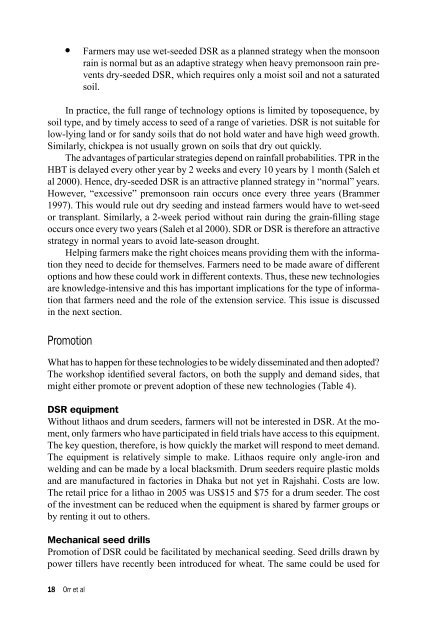Download (2461kB) - University of Greenwich
Download (2461kB) - University of Greenwich
Download (2461kB) - University of Greenwich
- No tags were found...
You also want an ePaper? Increase the reach of your titles
YUMPU automatically turns print PDFs into web optimized ePapers that Google loves.
Farmers may use wet-seeded DSR as a planned strategy when the monsoonrain is normal but as an adaptive strategy when heavy premonsoon rain preventsdry-seeded DSR, which requires only a moist soil and not a saturatedsoil.In practice, the full range <strong>of</strong> technology options is limited by toposequence, bysoil type, and by timely access to seed <strong>of</strong> a range <strong>of</strong> varieties. DSR is not suitable forlow-lying land or for sandy soils that do not hold water and have high weed growth.Similarly, chickpea is not usually grown on soils that dry out quickly.The advantages <strong>of</strong> particular strategies depend on rainfall probabilities. TPR in theHBT is delayed every other year by 2 weeks and every 10 years by 1 month (Saleh etal 2000). Hence, dry-seeded DSR is an attractive planned strategy in “normal” years.However, “excessive” premonsoon rain occurs once every three years (Brammer1997). This would rule out dry seeding and instead farmers would have to wet-seedor transplant. Similarly, a 2-week period without rain during the grain-filling stageoccurs once every two years (Saleh et al 2000). SDR or DSR is therefore an attractivestrategy in normal years to avoid late-season drought.Helping farmers make the right choices means providing them with the informationthey need to decide for themselves. Farmers need to be made aware <strong>of</strong> differentoptions and how these could work in different contexts. Thus, these new technologiesare knowledge-intensive and this has important implications for the type <strong>of</strong> informationthat farmers need and the role <strong>of</strong> the extension service. This issue is discussedin the next section.PromotionWhat has to happen for these technologies to be widely disseminated and then adopted?The workshop identified several factors, on both the supply and demand sides, thatmight either promote or prevent adoption <strong>of</strong> these new technologies (Table 4).DSR equipmentWithout lithaos and drum seeders, farmers will not be interested in DSR. At the moment,only farmers who have participated in field trials have access to this equipment.The key question, therefore, is how quickly the market will respond to meet demand.The equipment is relatively simple to make. Lithaos require only angle-iron andwelding and can be made by a local blacksmith. Drum seeders require plastic moldsand are manufactured in factories in Dhaka but not yet in Rajshahi. Costs are low.The retail price for a lithao in 2005 was US$15 and $75 for a drum seeder. The cost<strong>of</strong> the investment can be reduced when the equipment is shared by farmer groups orby renting it out to others.Mechanical seed drillsPromotion <strong>of</strong> DSR could be facilitated by mechanical seeding. Seed drills drawn bypower tillers have recently been introduced for wheat. The same could be used for18 Orr et al
















